CSFA/TAMU Press Book Series
The Center’s book series includes site reports and syntheses of important topics in First American studies. The following books can be purchased from the Texas A&M University Press.
Current Center members enjoy a 20% discount on these books!
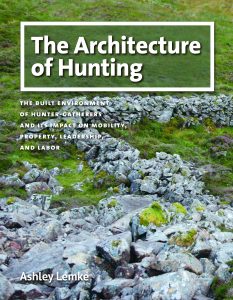
The Architecture of Hunting – The Built Environment of Hunter-Gatherers and Its Impact on Mobility, Property, Leadership, and Labor
By Ashley Lemke
Combining underwater archaeology, terrestrial archaeology, and ethnographic and historical research, The Architecture of Hunting investigates the creation and use of hunting architecture by hunter-gatherers. Hunting architecture—including blinds, drive lanes, and fishing weirs—is a global phenomenon found across a broad spectrum of cultures, time, geography, and environments.
Using examples of hunting architecture from across the globe and how they influence forager mobility, territoriality, property, leadership, and labor aggregation, Ashley Lemke explores this architecture as a form of human niche construction and considers the myriad ways such built structures affect hunter-gatherer lifeways. Bringing together diverse sources under the single category of “hunting architecture,” The Architecture of Hunting serves as the new standard guide for anyone interested in hunter-gatherers and their built environment.
> Order this book from Texas A&M University Press>>
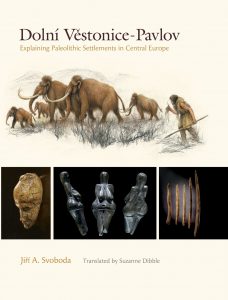
Dolní Věstonice–Pavlov
Explaining Paleolithic Settlements in Central Europe
By Jirí A. Svoboda
Perhaps the oldest modern human settlement in Europe, the archaeological site at Dolní Věstonice–Pavlov, located in the rolling, forested plains just north of the Danube River, has yielded a treasure trove of Ice Age artifacts since its first excavation in 1924. Being gifted artisans, the people lived here some 30,000 years ago created striking jewelry and figurines including the notable Venus of Dolní Větstonice, one of the oldest known ceramic artifacts in the world.
This first English translation of Dolní Věstonice–Pavlov: Explaining Paleolithic Settlements in Central Europe with its splendid illustrations is sure to provide vital information, insightful, and thought-provoking background for all readers.
Fun fact, Jean Auel, author of Clan of the Cave Bear, credits her inspiration and the technical accuracy of Paleolithic life expressed in her novel to research at Dolní Větstonice!
> Order this book from Texas A&M University Press>>
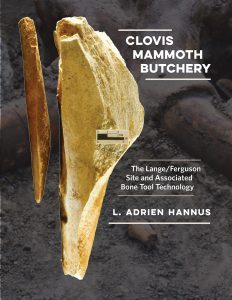
Clovis Mammoth Butchery
The Lange/Ferguson Site and Associated Bone Tool Technology L. Adrien Hannus
With Contributions by C. Vance Haynes Jr., Pat Shipman, Marvin Kay, Eric C. Grimm, Glen G. Fredlund, Manuel R. Palacios-Fest, and A. Byron Leonard
Clovis Mammoth Butchery offers readers a rare glimpse into a singular moment in prehistory that captures human interaction with extinct animals during a rapidly changing world for which there is no modern comparison. This book shares great insight into hunting and procurement strategies used by big game hunters during the Late Pleistocene and Early Holocene.
> Order this book from Texas A&M University Press>>
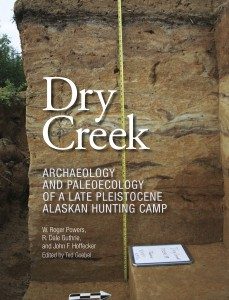 Dry Creek: Archaeology and Paleoecology of a Late Pleistocene Alaskan Hunting Camp W. Roger Powers, R. Dale Guthrie, and John F. Hoffecker Edited by Ted Goebel
Dry Creek: Archaeology and Paleoecology of a Late Pleistocene Alaskan Hunting Camp W. Roger Powers, R. Dale Guthrie, and John F. Hoffecker Edited by Ted Goebel
With cultural remains dated unequivocally to 13,000 calendar years ago, Dry Creek assumed major importance upon its excavation and study by W. Roger Powers. The site was the first to conclusively demonstrate a human presence that could be dated to the same time as the Bering Land Bridge. As Powers and his team studied the site, their work verified initial expectations. Unfortunately, the research was never fully published.
> Order this book from Texas A&M University Press>>
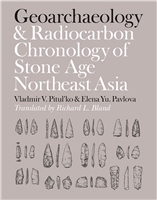
Geoarchaeology and Radiocarbon Chronology of Stone Age Northeast Asia
Vladimir V. Pitul’ko and Elena Yu. Pavlova
Translated by Richard L. Bland
This English translation of a work previously published in Russian (Geoarkheologiya i radiouglerodnaya khronologiya kamennogo veka Severo Vostochnoi Azii, St. Petersburg: Nauka, 2010) presents an overview of the Paleolithic archaeology of Northeast Asia, with emphasis on geoarchaeological and radiocarbon-based chronology. Although archaeological investigations above the Arctic Circle began more than two hundred years ago, access to and publication of findings has been difficult. In Geoarchaeology and Radiocarbon Chronology of Stone Age Northeast Asia, veteran researchers Vladimir V. Pitul’ko and Elena Yu. Pavlova have gathered and analyzed the available data to provide comprehensive documentation of human occupation of continental territories far above the Arctic Circle in the late Neopleistocene (also known as the Late Pleistocene era).
>Order this book from Texas A&M University Press>>
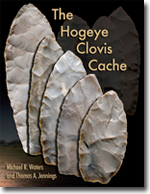
The Hogeye Clovis Cache
Michael R. Waters and Thomas A. Jennings
This book provides a well-illustrated, thoroughly analyzed description and discussion of the Hogeye Clovis cache, the projectile points and other artifacts from later occupations, and the geological context of the site, which has yielded evidence of multiple Paleoindian, Archaic, and Late Prehistoric occupations. The cache of tools and weapons at Hogeye, when combined with other sites, allows us to envision a snapshot of life at the end of the last Ice Age.
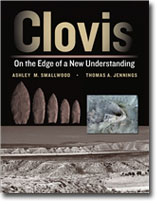
Clovis: On the Edge of a New Understanding
Edited by Ashley M. Smallwood and Thomas A. Jennings
New research and the discovery of multiple archaeological sites predating the established age of Clovis (13,000 years ago) provide evidence that the Americas were first colonized at least one thousand to two thousand years before Clovis. These revelations indicate to researchers that the peopling of the Americas was perhaps a more complex process than previously thought. The Clovis culture remains the benchmark for chronological, technological, and adaptive comparisons in research on peopling of the Americas. In seventeen chapters, the researchers provide their current perspectives of the Clovis archaeological record as they address the question: What is and what is not Clovis?
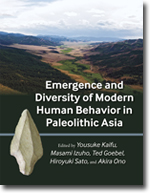
Emergence and Diversity of Modern Human Behavior in Paleolithic Asia
Edited by Yousuke Kaifu, Masami Izuho, Ted Goebel, Hiroyuki Sato, and Akira Ono
Arising from a 2011 symposium sponsored by the National Museum of Nature and Science in Tokyo, this book gathers the work of archaeologists from the Pacific Rim of Asia, Australia, and North America, to address the relative lack of attention given to the emergence of modern human behavior as manifested in Asia during the worldwide dispersal from Africa.
> Order this book from Texas A&M University Press >>
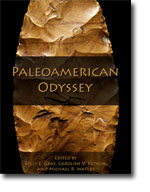
Paleoamerican Odyssey
Edited by Kelly E. Graf, Caroline V. Ketron, and Michael R. Waters
Volume consists of the full-length text of 31 papers orally presented at the 2013 Paleoamerican Odyssey Conference in Santa Fe, New Mexico. The volume provides an up-to-date view on the status of First Americans research and the new directions in which the dynamic field is moving. Research being presented fall into five parts: Human Dispersals in the Old World and Beringia, Dispersal Routes to the New World: Archaeology and Genetics, Clovis-era Archaeology and Ecology, News from Latin America and Pre-Clovis Archaeology.
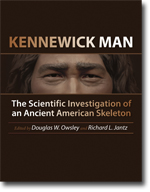
Kennewick Man
Edited by Douglas W. Owsley and Richard L. Jantz
Almost from the day of its accidental discovery along the banks of the Columbia River in Washington State in July 1996, the ancient skeleton of Kennewick Man has garnered significant attention from scientific and Native American communities as well as public media outlets. This volume represents a collaboration among physical and forensic anthropologists, archaeologists, geologists, and geochemists, among others, and presents the results of the scientific study of this remarkable find. Scholars address a range of topics, from basic aspects of osteological analysis to advanced research focused on Kennewick Man’s origins and his relationships to other populations. Interdisciplinary studies, comprehensive data collection and preservation, and applications of technology are all critical to telling Kennewick Man’s story.
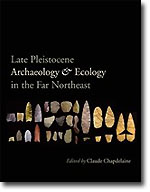
Late Pleistocene Archaeology and Ecology in the Far Northeast
Edited by Claude Chapdelaine
The Far Northeast, a peninsula incorporating the six New England states, New York east of the Hudson, Quebec south of the St. Lawrence River and Gulf of St. Lawrence, and the Maritime Provinces, provided the setting for a distinct chapter in the peopling of North America. Late Pleistocene Archaeology and Ecology in the Far Northeast focuses on the Clovis pioneers and their eastward migration into this region, inhospitable before 13,500 years ago, especially in its northern latitudes.
Bringing together the last decade or so of research on the Paleoindian presence in the area, Claude Chapdelaine and the contributors to this volume discuss, among other topics, the style variations in the fluted points left behind by these migrating peoples, a broader disparity than previously thought. This book offers not only an opportunity to review new data and interpretations in most areas of the Far Northeast, including a first glimpse at the Cliche-Rancourt Site, the only known fluted point site in Quebec, but also permits these new findings to shape revised interpretations of old sites. The accumulation of research findings in the Far Northeast has been steady, and this timely book presents some of the most interesting results, offering fresh perspectives on the prehistory of this important region.
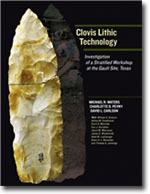
Clovis Lithic Technology:
Investigation of a Stratified Workshop at the Gault Site, Texas
By Michael R. Waters, Charlotte D. Pevny, and David L. Carlson
Some 13,000 years ago, humans were drawn repeatedly to a small valley in what is now Central Texas, near the banks of Buttermilk Creek. These early hunter-gatherers camped, collected stone, and shaped it into a variety of tools they needed to hunt game, process food, and subsist in the Texas wilderness. Their toolkit included bifaces, blades, and deadly spear points. Where they worked, they left thousands of pieces of debris, which have allowed archaeologists to reconstruct their methods of tool production. Along with the faunal material that was also discarded in their prehistoric campsite, these stone, or lithic, artifacts afford a glimpse of human life at the end of the last ice age during an era referred to as Clovis. The area where these people roamed and camped, called the Gault site, is one of the most important Clovis sites in North America. A decade ago a team from Texas A&M University excavated a single area of the site–formally named Excavation Area 8, but informally dubbed the Lindsey Pit–which features the densest concentration of Clovis artifacts and the clearest stratigraphy at the Gault site. Some 67,000 lithic artifacts were recovered during fieldwork, along with 5,700 pieces of faunal material. In a thorough synthesis of the evidence from this prehistoric “workshop,” Michael R. Waters and his coauthors provide the technical data needed to interpret and compare this site with other sites from the same period, illuminating the story of Clovis people in the Buttermilk Creek Valley.
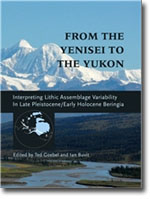
From the Yenisei to the Yukon:
Interpreting Lithic Assemblage Variability in Late Pleistocene/Early Holocene Beringia
Edited by Ted Goebel and Ian Buvit
Who were the first people who came to the land bridge joining northeastern Asia to Alaska and the northwest of North America? Where did they come from? How did they organize technology, especially in the context of settlement behavior?
During the Pleistocene era, the people now known as Beringians dispersed across the varied landscapes of late-glacial northeast Asia and northwest North America.
The twenty chapters gathered in this volume explore, in addition to the questions posed above, how Beringians adapted in response to climate and environmental changes. They share a focus on the significance of the modern-human inhabitants of the region. By examining and analyzing lithic artifacts, geoarchaeological evidence, zooarchaeological data, and archaeological features, these studies offer important interpretations of the variability to be found in the early material culture the first Beringians.
The scholars contributing to this work consider the region from Lake Baikal in the west to southern British Columbia in the east. Through a technological-organization approach, this volume permits investigation of the evolutionary process of adaptation as well as the historical processes of migration and cultural transmission. The result is a closer understanding of how humans adapted to the diverse and unique conditions of the late Pleistocene.
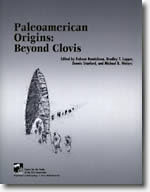 Paleoamerican Origins: Beyond Clovis
Paleoamerican Origins: Beyond Clovis
Edited by Robson Bonnichsen, Bradley T. Lepper, Dennis Stanford, and Michael R. Waters
Paleoamerican Origins is an outgrowth of the Clovis and Beyond Conference held in Santa Fe, New Mexico, in 1999. This book presents 23 up-to-date syntheses of important topics surrounding the debate over the initial prehistoric colonization of the Americas. These papers are written by some of the foremost authorities who are on the trail of the first Americans. The papers in this volume include a discussion of the archaeological evidence for Clovis and Pre-Clovis sites in North America (11 papers) and South America (2 papers). In addition, papers on the genetic evidence (2 papers) and skeletal evidence (4 papers) provide insights into the origins of the first Americans. Additional papers include ideas on the changing perceptions of Paleoamerican prehistory, public policy and science, and a comprehensive concluding synthesis.
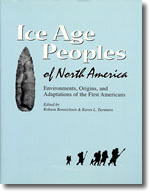
Ice Age Peoples of North America:
Environments, Origins, and Adaptations of the First Americans
Edited by Robson Bonnichsen and Karen L. Turnmire
This volume provides an up-to-date summary of important new discoveries from Northeast Asia and North America that are changing perceptions about the origin of the First Americans. Even though the peopling of the Americas has been the focus of scientific investigations for more than half a century, there is still no definitive evidence that will allow specialists to say when the First Americans initially arrived or who they were.
The nineteen papers collected here provide regional archaeological syntheses and address such topics as ice marginal dynamics, the impact of plant nutrients in glacial margins, and periglacial ecology of large mammals. The concluding chapter discusses conceptual frameworks used to explain the peopling of the Americas.
This volume provides an up-to-date summary of important new discoveries earlier than ten thousand years old from Northeast Asia and North America that are changing our perceptions about the origin of the First Americans. It offers a detailed compendium of late-Pleistocene Paleoamerican archaeological records that can serve as a foundation of existing knowledge in this field and for creating the next generation of models that seek to explain the peopling of the Americas.
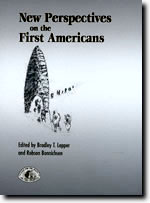
New Perspectives on the First Americans
Edited by Bradley T. Lepper and Robson Bonnichsen
The field of first American studies is undergoing significant changes. The traditional model that the Americas were only peopled once by Clovis big-game hunters from Siberia at the end of the last Ice Age has seriously been challenged. Most now believe that the Americas were peopled more than once.
Against this backdrop of controversy, the CSFA and its partners convened the Clovis and Beyond Conference in Santa Fe, New Mexico, in 1999, and brought many of the major players of the field to the conference forum who have a stake in the future of America’s past.
New Perspectives on the First Americans contains short and concise papers from this conference that focus on the following themes: pre-Clovis archaeology, Clovis-era archaeology, Paleoamerican paleobiology, new approaches to the study of Paleoamericans, Paleoamericans and public policy, and new directions for Paleoamerican archaeology.
Collectively, these papers represent the intellectual ferment in a field seeking to reconcile itself with changing scientific developments in an evolving social/political context.
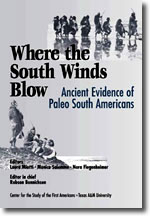
Where the South Winds Blow:
Ancient Evidence for Paleo South Americans
Edited by Laura Miotti, Monica Salemme, Nora Flegenheimer; Editor in Chief: Robson Bonnichsen
The early prehistory of South America is poorly known by the English speaking world. This edited volume, translated from Spanish, contains twenty-one short papers documenting some of the most important recently investigated early archaeological sites from South America.
These papers report Paleoamerican complexes and excavations of sites older than eleven thousand radiocarbon years before present, as well as cover issues in geoarchaeology, geochronology, Pleistocene extinction, and paleoecology. Numerous graphics are used to illustrate site locations, excavations, and artifacts.
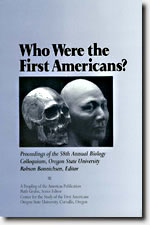 Who Were the First Americans
Who Were the First Americans
Edited by Robson Bonnichsen
Proceedings of the 58th Annual Biology Colloquium, Oregon State University.
Seven chapters include genetic and craniometric studies and what they mean in regard to the initial peopling of the Americas.
Order this book from Texas A&M University Press >>
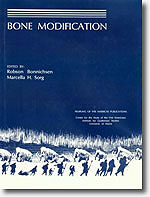
Bone Modification
Edited by Robson Bonnichsen and Marcella H. Slog
Thirty chapters provide a comprehensive discussion of the human modification of animal bones through breaking, polishing, and flaking to produce expedient and formal tools. Authorities from around the world provide insights into bone taphonomy and how to interpret modified bones from archaeological contexts. Bone tools and other modified bones from sites in North America, Asia, Africa, and Europe are discussed and cover the range from early hominids to Clovis. Other chapters include discussions of experimental replication of bone breakage patterns and tool manufacture, ethnographic examples of the modification of bone, bone use-wear studies, and the interpreting and documenting of modified bone from archaeological sites.
This book is out of print
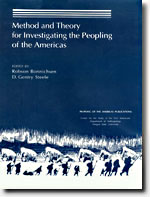
Method and Theory for Investigating the Peopling of the Americas
Edited by Robson Bonnichsen and D. Gentry Steele
Sixteen chapters provide an overview of important topics in First Americans research. Leading authorities in the field discuss the history of archaeological investigations into the peopling of the Americas, AMS radiocarbon dating, geoarchaeology of Paleoindian sites, blood residue analysis on stone tools, and an evaluation of the Pacific coast migration route from Asia to North America. Several chapters provide valuable information on the biological and linguistic evidence for the first pioneers to the Americas.
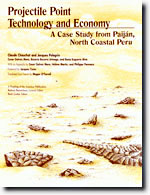
Projectile Point Technology and Economy
A Case Study from Paiján, North Coastal Peru: Pampa de Los Fosiles 14, Unit 1
Edited by Claude Chauchat and Jacques Pelegrin
The Paijan complex, of late Pleistocene to early Holocene age, is known from numerous open-air sites and one rock shelter and occurs more than one thousand kilometers off the Peruvian coastal desert. Claude Chauchat and his team present a detailed archaeological case study of the Cupisnique region at the Pampa de Los Fosilies locality on the north coast of Peru. This volume exemplifies the use of the Chaine operationaire approach, which views lithic assemblages as a succession of technical actions beginning at the moment of raw material acquisition, manufacture, utilization, and finally abandonment of tools.
This case study documents raw material use at flaking loci, description of cores, flakes, flake tools, limaces, bifaces, and lithic reduction practices of the Paijan site occupants. In addition to providing a detailed history of stone tool flaking activities, raw material acquisition patterns combined with regional survey data provide the foundation for inferring mobility models for the Paijan people.
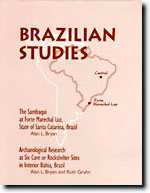
Brazilian Studies
The Sambaqui at Forte Marechal Luz, State of Santa Catarina, Brazil: Archeological Research at Six Cave or Rockshelter Sites
By Alan L. Bryan
Brazilian Studies includes an analysis of the Sambaqui at Forte Marechal Luz in Santa Catarina on Brazil’s south coast, plus archaeological research at six cave or rockshelter sites in interior Bahia.
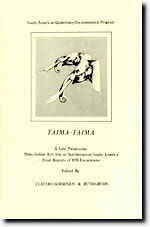
Taima-Taima
A Late Pleistocene Paleo-Indian Kill Site in Northernmost South America
– Final Reports of 1976 Excavations –
Edited by Claudio Ochsenius and Ruth Gruhn
A reprint from the South American Quaternary Documentation Program reporting on a northern Venezuela Paleoindian kill site, this volume includes examinations of environment, excavations, stratigraphy, dating, artifacts, faunal analysis, mastodon procurement, and the Taima-Taima site in context.
